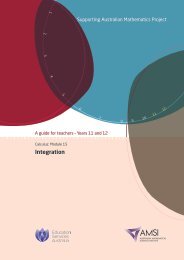Probability - the Australian Mathematical Sciences Institute
Probability - the Australian Mathematical Sciences Institute
Probability - the Australian Mathematical Sciences Institute
- No tags were found...
You also want an ePaper? Increase the reach of your titles
YUMPU automatically turns print PDFs into web optimized ePapers that Google loves.
A guide for teachers – Years 11 and 12 • {43}cdefghWith a sufficiently vigorous and lengthy shake, <strong>the</strong> mixing is random, leading to nopreference for any outcome, assuming a symmetric die.An overhand shuffle needs to be done for a very long time to produce randomnessin <strong>the</strong> order of <strong>the</strong> pack, relative to <strong>the</strong> starting order. If <strong>the</strong> shuffle is done just a fewtimes, traces of <strong>the</strong> original order will persist.A riffle shuffle produces a random order much more effectively than an overhandshuffle.It seems clear that this blast of air produces such chaotic and extensive mixing of <strong>the</strong>balls that, assuming <strong>the</strong> balls are of uniform size, shape and weight, all outcomes willbe (close to) equally likely.Historically, random number generators have been of varying quality; it depends on<strong>the</strong> method used. Most computer games now use algorithms that will not producedetectable non-randomness.A simple physical device like this may well have inadequate mixing.Exercise 6What you get depends on <strong>the</strong> specific coin. Were you surprised by your results?Exercise 7There are indeed five possibilities for <strong>the</strong> number of aces in <strong>the</strong> hand. But <strong>the</strong>se differentpossibilities are not equally likely. A standard deck has 52 cards. There are thousandsof equiprobable distinct hands of four cards that can be dealt: 270 725, to be precise.Only one of <strong>the</strong>se possible hands contains all 4 aces, whereas <strong>the</strong>re are many hands thatcontain no aces. So <strong>the</strong> chance of four aces isno aces is much greater.1270 725, while <strong>the</strong> probability of a hand withExercise 8There is some simple reasoning to be applied here. Consider <strong>the</strong> ballot for <strong>the</strong> first halfof <strong>the</strong> year, in which 29 February could be selected. In most years, no men born on29 February could be recruited, even if that marble came up, since <strong>the</strong>ir birth year wasnot a leap year (for example, in 1965 <strong>the</strong> birth year was 1945). In years such as 1968,<strong>the</strong> men turning 20 were born in <strong>the</strong> leap year of 1948, and some would have been bornon 29 February. For those men born on 29 February 1948, <strong>the</strong>ir chances of conscriptionwere <strong>the</strong> same as o<strong>the</strong>r men born in <strong>the</strong> first half of 1948.In fact, <strong>the</strong>re were only two relevant leap years, 1948 and 1952, involving conscription in<strong>the</strong> years 1968 and 1972. The date 29 February came up in <strong>the</strong> selected marbles in 1972and not in 1968.
















